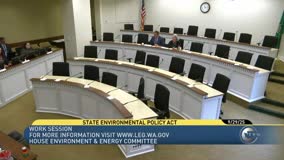Puget Sound Energy warns permitting unpredictability threatens near-term reliability goals
September 29, 2025 | Legislative Sessions, Washington
This article was created by AI summarizing key points discussed. AI makes mistakes, so for full details and context, please refer to the video of the full meeting. Please report any errors so we can fix them. Report an error »

Puget Sound Energy (PSE) told the House Environment & Energy Committee that the utility must acquire thousands of megawatts of new clean energy to meet state targets and that permitting uncertainty and inconsistent SEPA applications across local jurisdictions threaten predictable timelines.
"We are needing to acquire significant new clean energy at an unprecedented rate and scale," PSE director Sarah Labourette said, noting the utility serves about 1.2 million electric and 900,000 gas customers. Labourette said PSE's 2023 progress report estimated the company would need roughly 6,700 megawatts of new clean-energy capacity by 2030 to meet statutory objectives.
Labourette described two intersecting challenges. First, CETA-era procurement requires more dispatchable and intermittent resources than in the past; second, local SEPA and permitting expertise varies by jurisdiction. She described a 16-mile reconductoring project that took ten years because five jurisdictions needed to be educated and engaged on technical issues. PSE said programmatic EISs and statewide tools may help produce more consistent applications and mitigation packages, but the company still expects long timelines for long‑haul transmission projects and urged state-level leadership to create more predictable permitting pathways.
Committee members asked about possible fuel mixes to firm supply in the near term. Labourette said PSE is pursuing an "all of the above" strategy within the bounds of CETA and investor caution: options include geothermal, hydrogen in the longer term, new wind or solar (often remote), and technologies that can provide firm dispatchability. On the question of using hydropower to firm renewables, Labourette said PSE operates hydro assets such as Baker and Snoqualmie but was not aware of near-term opportunities to site new hydropower; she offered to connect legislators with utility staff on any identified hydro opportunities.
Ending: PSE said it supports clearer, more consistent permitting processes and anticipates continuing long lead times for major transmission, asking the Legislature to consider policies that raise predictability while the utility pursues multiple technology options to meet statutory clean-energy goals.
"We are needing to acquire significant new clean energy at an unprecedented rate and scale," PSE director Sarah Labourette said, noting the utility serves about 1.2 million electric and 900,000 gas customers. Labourette said PSE's 2023 progress report estimated the company would need roughly 6,700 megawatts of new clean-energy capacity by 2030 to meet statutory objectives.
Labourette described two intersecting challenges. First, CETA-era procurement requires more dispatchable and intermittent resources than in the past; second, local SEPA and permitting expertise varies by jurisdiction. She described a 16-mile reconductoring project that took ten years because five jurisdictions needed to be educated and engaged on technical issues. PSE said programmatic EISs and statewide tools may help produce more consistent applications and mitigation packages, but the company still expects long timelines for long‑haul transmission projects and urged state-level leadership to create more predictable permitting pathways.
Committee members asked about possible fuel mixes to firm supply in the near term. Labourette said PSE is pursuing an "all of the above" strategy within the bounds of CETA and investor caution: options include geothermal, hydrogen in the longer term, new wind or solar (often remote), and technologies that can provide firm dispatchability. On the question of using hydropower to firm renewables, Labourette said PSE operates hydro assets such as Baker and Snoqualmie but was not aware of near-term opportunities to site new hydropower; she offered to connect legislators with utility staff on any identified hydro opportunities.
Ending: PSE said it supports clearer, more consistent permitting processes and anticipates continuing long lead times for major transmission, asking the Legislature to consider policies that raise predictability while the utility pursues multiple technology options to meet statutory clean-energy goals.
View full meeting
This article is based on a recent meeting—watch the full video and explore the complete transcript for deeper insights into the discussion.
View full meeting
